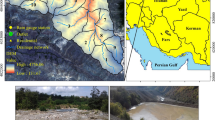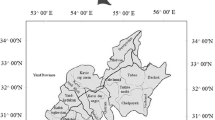Abstract
The sustainability concept has influenced decision-making patterns in various managerial fields. Watershed-based flood risk management (FRM), as an extremely complex multidisciplinary issue, has to deal with various conflicting, sustainable development criteria. The following measures through a novel structure were considered to address the complexity and uncertainty of watershed-based FRM: (1) the FRM strategies were formulated via matching internal strategic factors against external ones through Strength-Weakness-Opportunity-Threat (SWOT-TOWS) matrix; (2) a Multi Attribute Group Decision Making (MAGDM) process was applied to prioritize the strategies with consideration of sustainable development attributes; (3) the Interval-Valued Intuitionistic Fuzzy Numbers (IVIFNs) were merged into TOWS matrix as a novel procedure to overcome the uncertainty of the judgments. According to pairwise comparisons of the seven proposed attributes, the urgency of need was obtained as the first-ranked attribute. The overall prioritization of 10 TOWS-based strategies with IVIFNs revealed that the highest priority among the strategies belonged to implementation of social learning process to raise the residents’ awareness concerning water and soil conservation plus sustainable agriculture with the aid of NGOs. Throughout the present study, SWOT-TOWS matrix not only could properly identify the fundamental strategic factors but also developed the mitigation strategies including structurally and non-structurally-based measures. In addition to the IVIFNs, pairwise comparisons performed appropriately to evaluate the attributes’ weights. Finally, the proposed IVIFN-based MAGDM technique allows the analysts to aggregate several individual exact numerical scores of an attribute into an IVIFN through a simple, practical and straightforward group decision making mechanism.




Similar content being viewed by others
Abbreviations
- FRM:
-
Flood Risk Management
- SDA:
-
Sustainable Development Attribute
- MADM:
-
Multi Attributes Decision Making
- MAGDM:
-
Multi Attributes Group Decision Making
- AHP:
-
Analytic Hierarchy Process
- CR:
-
Consistency Ratio
- RI:
-
Random Index
- IFS:
-
Intuitionistic Fuzzy Set
- IVIFS:
-
Interval-Valued Intuitionistic Fuzzy Set
- IVIFNs:
-
Interval-Valued Intuitionistic Fuzzy Numbers
- SWOT–TOWS:
-
Strength-Weakness-Opportunity-Threat
- IFs:
-
Internal Factors
- EFs:
-
External Factors
- DM:
-
Decision-Maker
References
Afshar A, Mariño MA, Saadatpour M, Afshar A (2011) Fuzzy TOPSIS multi-criteria decision analysis applied to Karun reservoirs system. Water Resour Manag 25(2):545–563
Afzali A, Sabri S, Rashid M, Samani JMV, Ludin ANM (2014) Inter-municipal landfill site selection using analytic network process. Water Resour Manag 28(8):2179–2194
Ahmadisharaf E, Kalyanapu AJ, Chung ES (2015) Spatial probabilistic multi-criteria decision making for assessment of flood management alternatives. J Hydrol. doi:10.1016/j.jhydrol.2015.12.031
Ardakanian R, Zarghami M (2004) Sustainability criteria for ranking of water resources projects. Proceedings of the first national conference on water resources management, Iranian Water Resources Association, College of Engineering of University of Tehran, Tehran, Iran (In Persian)
Atanassov K (1986) Intuitionistic fuzzy sets. Fuzzy Sets Syst 20(1):87–96
Atanassov KT, Gargov G (1989) Interval valued intuitionistic fuzzy sets. Fuzzy Sets Syst 31(3):343–349
Atanassov K, Pasi G, Yager R (2005) Intuitionistic fuzzy interpretations of multi-criteria multi-person and multi-measurement tool decision making. Int J Syst Sci 36(14):859–868
Azarnivand A, Chitsaz N (2015) Adaptive policy-responses to water shortage mitigation in arid regions- a systematic approach based on eDPSIR, DEMATEL and MCDA. Environ Monit Assess 187(2):1–15
Azarnivand A, Hashemi-Madani FS, Banihabib ME (2014) Extended fuzzy analytic hierarchy process approach in water and environmental management (case study: Lake Urmia Basin, Iran). Environ Earth Scie 73(1):13–26
Balkema AJ, Preisig HA, Otterpohl R, Lambert FJD (2002) Indicators for the sustainability assessment of wastewater treatment systems. Urban Water 4(2):153–161
Basak I, Saaty T (1993) Group decision making using analytic hierarchy process. Math Comput Model 17(415):101–109
Bouwen R, Taillieu T (2004) Multi-party collaboration as social learning for interdependence: developing relational knowing for sustainable natural resource management. J Commun Applied Soc Psychol 14(3):137–153
Chitsaz N, Banihabib ME (2015) Comparison of different multi criteria decision-making models in prioritizing flood management alternatives. Water Resour Manag 29(8):2503–2525
Fanghua H, Guanchun C (2010) A fuzzy multi-criteria group decision-making model based on weighted borda scoring method for watershed ecological risk management: a case study of three gorges reservoir area of China. Water Resour Manag 24(10):2139–2165
Ghanbarpour MR, Mohseni Saravi M, Salimi S (2014) Floodplain inundation analysis combined with contingent valuation: implications for sustainable flood risk management. Water Resour Manag 28(9):2491–2505
Halabi AX, Montoya-Torres JR, Obregón N (2012) A case study of group decision method for environmental foresight and water resources planning using a fuzzy approach. Group Decis Negot 21(2):205–232
Hashemi H, Bazargan J, Meysam Mousavi S (2013) A compromise ratio method with an application to water resources management: an intuitionistic fuzzy Set. Water Resour Manag 27(7):2029–2051
Hashemi H, Bazargan J, Meysam Mousavi S, Vahdani B (2014) An extended compromise ratio model with an application to reservoir flood control operation under an interval-valued intuitionistic fuzzy environment. Appl Math Model 38:3495–3511
Jaiswal RK, Ghosh NC, Lohani AK, Thomas T (2015) Fuzzy AHP based multi crteria decision support for watershed prioritization. Water Resour Manag 29(12):4205–4227
Johannessen A, Hahn T (2013) Social learning towards a more adaptive paradigm? reducing flood risk in kristianstad municipality, Sweden. Glob Environ Chang 23:372–381
Juwana I, Muttil N, Perera BJC (2012) Indicator-based water sustainability assessment — a review. Sci Total Environ 438:357–371
Kajanus M, Leskinen P, Kurttila M, Kangas J (2012) Making use of MCDS methods in SWOT analysis—lessons learnt in strategic natural resources management. Forest Pol Econ 20:1–9
Kenyon W (2007) Evaluating flood risk management options in Scotland: a participant-led multi-criteria approach. Ecol Econ 64:70–81
Kowalski K, Stagl S, Madlener R, Omann I (2009) Sustainable energy futures: methodological challenges in combining scenarios and participatory multi-criteria analysis. Eur J Oper Res 197:1063–1074
Lebel L (2013) Local knowledge and adaptation to climate change in natural resource-based societies of the Asia-pacific. Mitig Adapt Strateg Glob Chang 18(7):1057–1076
Levy JK (2005) Multiple criteria decision making and decision support systems for flood risk management. Stoch Env Res Risk A 19:438–447
Liu SL, Qiu WH (1998) Studies on the basic theories for MADM. Syst Eng Theory Pract 18(1):38–43
Makropoulos CK, Natsis K, Liu S, Mittas K, Butler D (2008) Decision support for sustainable option selection in integrated urban water management. Environ Model Softw 23:1448–1460
Medema W, Wals A, Adamowski J (2014) Multi-loop social learning for sustainable land and water governance: towards a research agenda on the potential of virtual learning platforms. NJAS - Wageningen J Life Sci 69(6):23–38. doi:10.1016/j.njas.2014.03.003
Mees HLP, Driessen PPJ, Runhaar HAC (2014) Legitimate adaptive flood risk governance beyond the dikes: the cases of Hamburg, Helsinki and Rotterdam. Reg Environ Chang 14:671–682
Mianabadi H, Sheikhmohammady M, Mostert E, Van de Giesen N (2014) Application of the ordered weighted averaging (OWA) method to the Caspian Sea conflict. Stoch Env Res Risk A 28(6):1359–1372
Newson MD (1997) Land, Water, and Development: River Basin Systems and Their Sustainable Management, 2nd ed, Routledge, London, England, 423.
Papaioannou G, Vasiliades L, Loukas A (2015) Multi-criteria analysis framework for potential flood prone areas mapping. J Water Resour Manag 29(2):399–418
Radmehr A, Araghinejad S (2015) Flood vulnerability analysis by fuzzy spatial multi criteria decision making. J Water Resour Manag 29(12):4427–4445
Regan HM, Colyvan M, Markovchick-Nicholls L (2006) A formal model for consensus and negotiation in environmental management. Aust J Environ Manag 80(2):167–176
Saaty TL (1980) The analytic hierarchy process: planning, priority setting, resources allocation. McGraw-Hill, London, 287 p
Schneider F, Rist S (2014) Envisioning sustainable water futures in a transdisciplinary learning process: combining normative, explorative, and participatory scenario approaches. Sustain Sci 9(4):463–481
Serhat A, Cengiz K (2011) A Modified Fuzzy Analytic Hierarchy Process Based Multicriteria Decision making Methodology for Assessing E-commerce Website Quality: A Case Study in Turkey. Proceedings of the World Congress on Engineering, Vol II. WCE, London, UK, July 6 – 8.
Simonovic SP, Burn DH, Lence BJ (1997) Practical sustainability criteria for decision-making. Int J Sustain Dev World Ecol 4(4):231–244
Srdjevic B, Medeiros YDP (2008) Fuzzy AHP assessment of water management plans. Water Resour Manag 22(7):877–894
Toosi SR, Samani JMV (2014) A new integrated MADM technique combined with ANP, FTOPSIS and fuzzy Max-Min set method for evaluating water transfer projects. Water Resour Manag 28(12):4257–4272
Tsakiris G, Spiliotis M (2011) Planning against long term water scarcity: a fuzzy multicriteria approach. Water Resour Manag 25(4):1103–1129
Weihrich H (1982) The TOWS matrix: tool for situational analysis. Long Range Plan 15(2):54–66
Wisner B (2010) Climate change and cultural diversity. Int Soc Sci J 61:131–140
World Meteorological Organization [WMO] (2006) Social aspects and stakeholder involvement in integrated flood management. Associated Programme on Flood Management, WMO-No. 1008. www.adpc.net/v2007/ Resource/downloads/socialaspect13oct_2.pdf
Xu ZS (2007) Methods for aggregating interval-valued intuitionistic fuzzy information and their application to decision making. Control Des 22(2):215–219
Yang XL, Ding JH, Hou H (2013) Application of a triangular fuzzy AHP approach for flood risk evaluation and response measures analysis. Nat Hazards 68(2):657–674
Yazdandoost F, Bozorgy B (2008) Flood risk management strategies using multi-criteria analysis. Proc ICE-Water Manag 161(5):261–266
Yue Z (2011) A method for group decision-making based on determining weights of decision makers using TOPSIS. Appl Math Model 35(4):1926–1936
Yue Z, Jia Y (2013) A method to aggregate crisp values into interval-valued intuitionistic fuzzy information for group decision making. Appl Soft Comput 13:2304–2317
Zadeh LA (1965) Fuzzy sets. Inf Control 8(3):338–353
Zagonari F, Rossi C (2013) A heterogeneous multi-criteria multi-expert decision-support system for scoring combinations of flood mitigation and recovery options. Environ Model Softw 49:152–165
Zarghami M, Szidarovszky F (2011) Multicriteria analysis: applications to water and environment management. Springer, Berlin, p 195
Acknowledgments
The authors would like to acknowledge insightful comments from the anonymous reviewer and the associate editor on the previous version of the manuscript.
Author information
Authors and Affiliations
Corresponding author
Rights and permissions
About this article
Cite this article
Azarnivand, A., Malekian, A. Analysis of Flood Risk Management Strategies Based on a Group Decision Making Process via Interval-Valued Intuitionistic Fuzzy Numbers. Water Resour Manage 30, 1903–1921 (2016). https://doi.org/10.1007/s11269-016-1259-0
Received:
Accepted:
Published:
Issue Date:
DOI: https://doi.org/10.1007/s11269-016-1259-0




